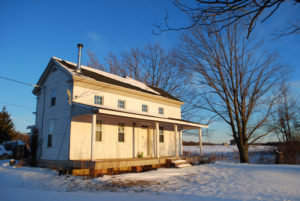The Solstice
During these short days of winter, enjoy the rays of sun beaming into the south windows of your home, fix yourself a nice hot cup of coffee, tea or hot chocolate and enjoy Bill’s thoughts.

Many early houses were built with windows facing a southern exposure to maximize passive solar warmth in the winter. Photo by Violet Stone
Next Monday is the Winter Solstice, the shortest day in the Northern Hemisphere and the beginning of the increase in sunlight which will bring us to the Summer Solstice in just 6 months.
On December 21, at 9:43 a.m., the sun will be directly overhead at the Tropics of Capricorn, 23 degrees below the equator in the Southern Hemisphere. The rotation of the Earth around the sun and the relatively fixed orientation of the Earth’s axis bring the Tropic of Capricorn closet to the sun on the Winter Solstice. At the time of the Summer Solstice, the Tropic of Cancer (23 degrees north of the equator) is closest, and at the equinoxes, the equator is nearest the sun.
The solstice, meaning the sun halts or stands still, is similar to what happens to a ball thrown into the air. The ball slows down as it reaches its highest point, stops briefly and then begins its downward acceleration. The rate of change in day-length and in the altitude of the sun is very slow around a solstice. These changes pick up speed until the equinox, when the rate of change is the greatest. The rapidly-lengthening days in March are mirrored by the quickly-shortening days of September.
Our distant ancestors were well aware of the time of least light, and of the solstice as the beginning of the road which leads to summer. They celebrated the coming of the light. The Jewish Festival of Lights at this time of year probably evolved from ancient solstice celebrations, and the date of Christmas was placed near the solstice celebrations. Our seasonal decorations of trees, greens and lights have their roots in ancient festivals which connected people closely with their environment. The reliable, radiant, life-sustaining sun provides a metaphor for many religions.
On the Winter Solstice at our latitude (just above 41 degrees north), the sun rises about 60 degrees east of south, climbs to an altitude of 26 degrees at noon, and then sets 60 degrees west of south. This means that the sun spends most of the day shining on the south wall of our buildings. When we put windows on the south side, the sun radiates into our homes.
Practical people will say that it makes sense to have south-facing windows to save energy and cut down on heating and lighting bills. Spiritual people might say we should let the sun into our houses to create a mystical and symbolic connection to the sun as the energy source for life on our planet. Whatever your reason, for the next several months, south-facing windows provide the great sensual pleasure of being in a space filled with the light and warmth of the sun. Given that simple pleasure and the fact that many houses in this area built in colonial times have most of their windows on the south side, it is somewhere between stupid and criminal recently built, very expensive houses which have few, if any windows on the south side.
These houses are expressions of the outdated belief that we can live disconnected from the environment. Regardless of individual religious beliefs, we all need to get back in touch with the Earth in a way more like that of our distant ancestors.
We can now include in our thoughts the image of this beautiful blue and white sphere bathed in sunlight and covered with a fantastic variety of living things working together to make life on Earth possible.
We must share the Earth, home to all the life we know. Only by learning to live in peace with each other and with the environment, can we continue to live on the Earth well into the future.
Happy Solstice.
Reprint Permission:
Living on the Earth: Eclectic Essays for a Sustainable and Joyful Future includes essays from the first three of the ten years that Living on the Earth essays were aired weekly on public radio from Fairfield, CT. The essays were written by Bill Duesing and edited by Suzanne Duesing. Bill and Suzanne operate Old Solar Farm in Oxford, CT where they produce organic vegetables, fruits and poultry. The book is available for $10 plus $3 S&H from Solar Farm Education, Box 135, Stevenson, CT 06491.

